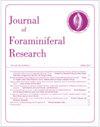大西洋中底栖有孔虫对阿普特阶-阿尔比阶碳循环扰动的响应
IF 0.7
4区 地球科学
Q4 PALEONTOLOGY
引用次数: 0
摘要
与海洋缺氧事件(OAE) 1b碳循环大扰动同时发生的浮游有孔虫大灭绝,发生在阿普天—阿布边边界区间(AABI)。然而,整个AABI的高分辨率记录的缺乏阻碍了对OAE 1b对深水底栖有孔虫组合影响的评估。在这里,我们展示了深海钻探项目(DSDP)站点511(南大西洋南部)和海洋钻探计划(ODP)站点1049(北大西洋副热带西部)在AABI上的高分辨率底栖有孔虫普查计数。我们在这些深海遗址的记录提供了确凿的证据,表明在阿普tian - Albian边界没有底栖有孔虫灭绝,尽管相对丰度发生了明显的重组。在最近的Aptian时期,这两个地点的动物物种丰度的循环增加表明,底部水氧合减少和向海底的有机碳通量增加的反复脉冲。此外,在最晚的Aptian时期,聚集和弱钙化的底栖有孔虫种类相对丰富,表明大西洋的深水碳酸盐离子枯竭,尽管我们没有在这些相对较浅的地点发现碳酸盐溶解的迹象。511站点的虫源有孔虫丰度与OAE 1b中基连次事件的负碳酸盐碳同位素(δ13Ccarb)偏移同步增加,表明该次事件期间底水通风量减少,向海底的有机碳通量增加。从511和1049站点重度钙化的脚上有孔虫丰度趋势可以看到,在大西洋最早的Albian时期,底水通气和碳酸盐离子饱和度有所改善,随后出现了高振幅振荡。本文章由计算机程序翻译,如有差异,请以英文原文为准。
Benthic Foraminiferal Response to the Aptian−Albian Carbon Cycle Perturbation in the Atlantic Ocean
A planktic foraminiferal mass extinction, coeval with the major carbon cycle perturbation of Oceanic Anoxic Event (OAE) 1b, occurred at the Aptian−Albian boundary interval (AABI). However, the scarcity of high-resolution records across the AABI hampers an assessment of the impacts of OAE 1b on deep-water benthic foraminiferal assemblages. Here we present high-resolution benthic foraminiferal census counts at Deep Sea Drilling Project (DSDP) Site 511 (southern South Atlantic Ocean) and Ocean Drilling Program (ODP) Site 1049 (western subtropical North Atlantic Ocean) over the AABI. Our records at these bathyal sites provide conclusive evidence that there was no benthic foraminiferal extinction at the Aptian−Albian boundary, although marked reorganizations of relative abundances occurred. During the latest Aptian, cyclic increases in the abundance of infaunal species at both sites point to repeated pulses of reduced bottom water oxygenation and increased organic carbon flux to the ocean floor. Additionally, agglutinated and weakly calcified benthic foraminiferal species were relatively abundant during the latest Aptian, suggesting deep-water carbonate ion depletion in the Atlantic Ocean, although we did not identify signs of carbonate dissolution at these relatively shallow sites. At Site 511, abundances of infaunal foraminifera increased in tandem with the negative carbonate carbon isotope (δ13Ccarb) excursion of the Kilian sub-event within OAE 1b, suggesting decreased bottom water ventilation and increased organic carbon flux to the ocean floor during the sub-event. Bottom water ventilation and carbonate ion saturation improved during the earliest Albian in the Atlantic Ocean, followed by high-amplitude oscillations, as suggested by abundance trends of heavily calcified epifaunal foraminifera at Sites 511 and 1049.
求助全文
通过发布文献求助,成功后即可免费获取论文全文。
去求助
来源期刊
CiteScore
2.10
自引率
9.10%
发文量
32
审稿时长
>12 weeks
期刊介绍:
JFR publishes original papers of international interest dealing with the Foraminifera and allied groups of organisms. Review articles are encouraged.

 求助内容:
求助内容: 应助结果提醒方式:
应助结果提醒方式:


